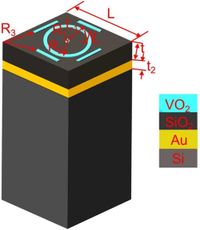Researchers at a collaborative effort have developed a groundbreaking tunable metasurface capable of functioning across five frequencies, paving the way for enhanced terahertz biological sample detection.
The design incorporates vanadium dioxide, a phase change material that allows for simultaneous control of absorptive and reflective states across a multi-resonant structure. This innovation promises to significantly improve detection methods for biological samples by enabling adjustable operational capabilities in the terahertz spectrum.
Vanadium dioxide operates effectively by switching conductivity based on temperature changes, specifically transitioning at around 341 K. This characteristic enables the metasurface to adapt its reflective or absorptive properties dynamically, which is crucial for detecting biological samples at varying terahertz frequencies.
The new metasurface unit cell is engineered with a three-layer architecture, comprising vanadium dioxide at the top, silicon dioxide in the middle, and a gold layer beneath it, yielding depths of 0.5, 4.9, and 0.05 micrometers, respectively. Such construction supports the device’s polarization insensitivity, a beneficial feature for preventing interference in real-world applications.
This innovation signals a notable advance from previous designs. Traditional tunable surfaces often struggled with limited operational capabilities, allowing shifts between only one or two frequencies. Past works, such as those designed by Li et al., demonstrated potential phase shifts at 1.1 THz but fell short of achieving true dynamic control. The breakthrough by the current research team establishes a versatile framework capable of achieving operational effectiveness across the entire 2–18 THz range.
In various test scenarios, researchers observed that the adjustment of silicon dioxide thickness directly affected the resonant frequencies. As thickness increased, certain frequencies migrated toward lower ranges, illustrating the complex interplay of material properties that govern metasurface behavior.
Navigating through potential points of frequency interference, the design allows from five unique resonant points optimized for their applications in environments such as biological detection. This quality is particularly critical when examining samples that could otherwise obscure signals in conventional setups.
Furthermore, simulations confirmed that reliable frequency shifts would adjust based on varying attributes like the radius of the vanadium dioxide patches. As such, the technology opens new avenues for in-depth signal analysis and detection not previously possible.
The implementation of a 10 x 10 metasurface array further enhances capabilities by increasing scattering intensity in varied states, a feature showcasing the scalable potential of the solution. This dynamic aspect mimics natural conditions and reflects the necessity for adaptive response in biosensing.
As pointed out in the findings, when the vanadium dioxide layer transitions to a non-metallic state, the resultant absorption peaks confirm successful activation of the detection process. The structure suppresses operational noise by ensuring that the non-metallic phase absorbs signals effectively, while conversely, wavelengths in the metallic state allow for reflection.
This groundbreaking research elucidates the exciting prospects of tunable metasurfaces and their applications in future biological detection technologies, directly addressing limitations faced with fixed-frequency methods. By harnessing the various attributes of the metasurface design, researchers have laid the groundwork for a new era of responsive and efficient biological sampling solutions.
Overall, this innovative metasurface represents a major leap toward fulfilling the increasing demands for advanced detection techniques in biotechnology, facilitating both precision in analysis as well as adaptability across various use cases.




